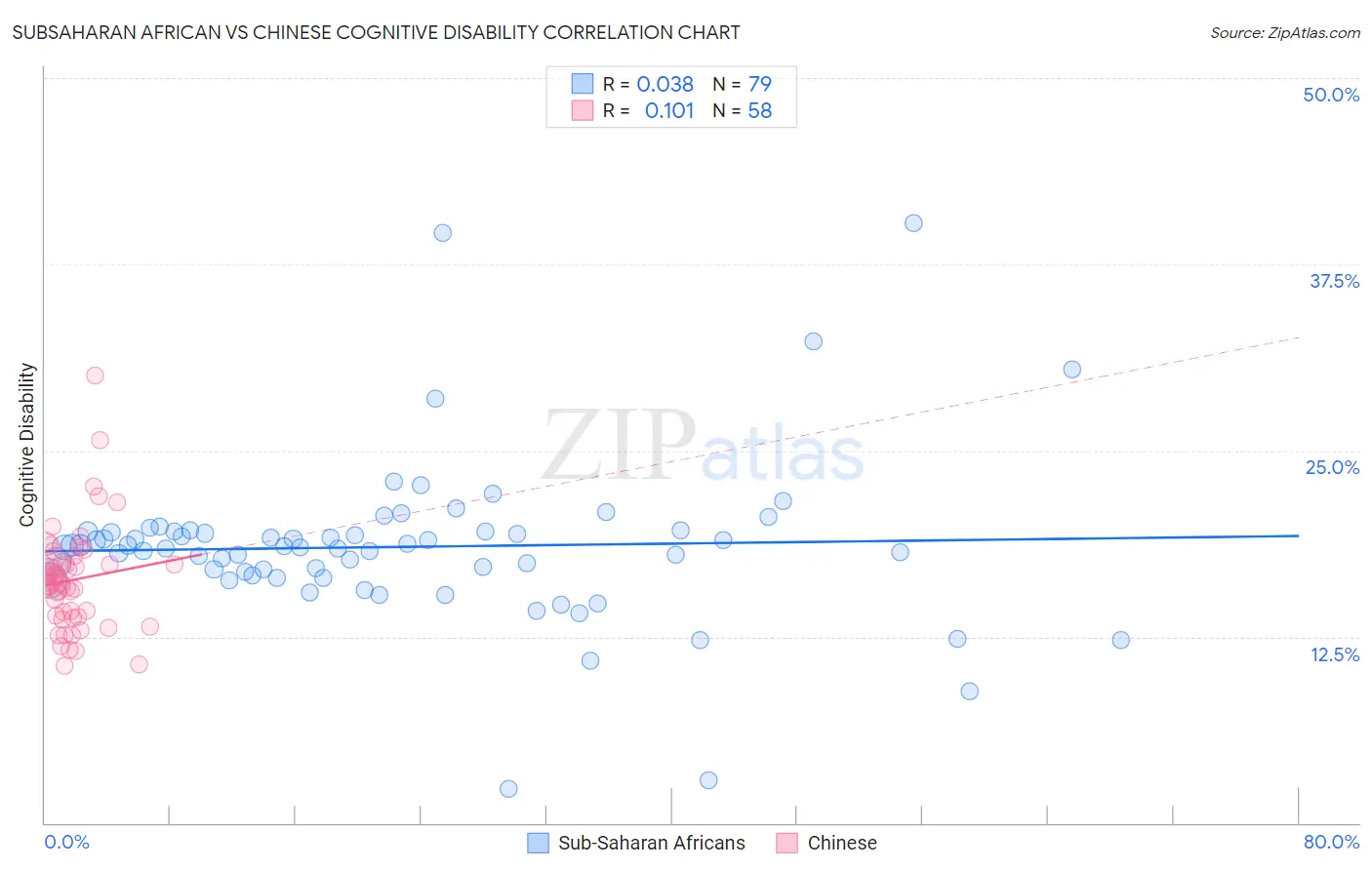Subsaharan African vs Chinese Cognitive Disability
COMPARE
Subsaharan African
Chinese
Cognitive Disability
Cognitive Disability Comparison
Sub-Saharan Africans
Chinese
18.5%
COGNITIVE DISABILITY
0.0/ 100
METRIC RATING
314th/ 347
METRIC RANK
15.9%
COGNITIVE DISABILITY
100.0/ 100
METRIC RATING
3rd/ 347
METRIC RANK
Subsaharan African vs Chinese Cognitive Disability Correlation Chart
The statistical analysis conducted on geographies consisting of 508,099,215 people shows no correlation between the proportion of Sub-Saharan Africans and percentage of population with cognitive disability in the United States with a correlation coefficient (R) of 0.038 and weighted average of 18.5%. Similarly, the statistical analysis conducted on geographies consisting of 64,802,428 people shows a poor positive correlation between the proportion of Chinese and percentage of population with cognitive disability in the United States with a correlation coefficient (R) of 0.101 and weighted average of 15.9%, a difference of 16.3%.

Cognitive Disability Correlation Summary
| Measurement | Subsaharan African | Chinese |
| Minimum | 2.3% | 10.5% |
| Maximum | 40.3% | 30.0% |
| Range | 38.0% | 19.5% |
| Mean | 18.5% | 16.3% |
| Median | 18.5% | 16.1% |
| Interquartile 25% (IQ1) | 16.6% | 13.9% |
| Interquartile 75% (IQ3) | 19.6% | 17.3% |
| Interquartile Range (IQR) | 2.9% | 3.4% |
| Standard Deviation (Sample) | 5.5% | 3.4% |
| Standard Deviation (Population) | 5.5% | 3.4% |
Similar Demographics by Cognitive Disability
Demographics Similar to Sub-Saharan Africans by Cognitive Disability
In terms of cognitive disability, the demographic groups most similar to Sub-Saharan Africans are Yaqui (18.5%, a difference of 0.060%), Chickasaw (18.5%, a difference of 0.17%), Immigrants from Dominica (18.6%, a difference of 0.18%), Immigrants from Middle Africa (18.6%, a difference of 0.26%), and Liberian (18.6%, a difference of 0.34%).
| Demographics | Rating | Rank | Cognitive Disability |
| Ugandans | 0.0 /100 | #307 | Tragic 18.3% |
| Immigrants | Western Africa | 0.0 /100 | #308 | Tragic 18.4% |
| Immigrants | Eastern Africa | 0.0 /100 | #309 | Tragic 18.4% |
| Choctaw | 0.0 /100 | #310 | Tragic 18.4% |
| Hmong | 0.0 /100 | #311 | Tragic 18.4% |
| Chickasaw | 0.0 /100 | #312 | Tragic 18.5% |
| Yaqui | 0.0 /100 | #313 | Tragic 18.5% |
| Sub-Saharan Africans | 0.0 /100 | #314 | Tragic 18.5% |
| Immigrants | Dominica | 0.0 /100 | #315 | Tragic 18.6% |
| Immigrants | Middle Africa | 0.0 /100 | #316 | Tragic 18.6% |
| Liberians | 0.0 /100 | #317 | Tragic 18.6% |
| Bangladeshis | 0.0 /100 | #318 | Tragic 18.6% |
| Comanche | 0.0 /100 | #319 | Tragic 18.6% |
| Apache | 0.0 /100 | #320 | Tragic 18.6% |
| Africans | 0.0 /100 | #321 | Tragic 18.6% |
Demographics Similar to Chinese by Cognitive Disability
In terms of cognitive disability, the demographic groups most similar to Chinese are Immigrants from India (15.9%, a difference of 0.080%), Immigrants from Lithuania (16.0%, a difference of 0.18%), Immigrants from Hong Kong (16.0%, a difference of 0.59%), Thai (16.1%, a difference of 1.2%), and Immigrants from Ireland (16.1%, a difference of 1.3%).
| Demographics | Rating | Rank | Cognitive Disability |
| Immigrants | Taiwan | 100.0 /100 | #1 | Exceptional 15.7% |
| Immigrants | India | 100.0 /100 | #2 | Exceptional 15.9% |
| Chinese | 100.0 /100 | #3 | Exceptional 15.9% |
| Immigrants | Lithuania | 100.0 /100 | #4 | Exceptional 16.0% |
| Immigrants | Hong Kong | 100.0 /100 | #5 | Exceptional 16.0% |
| Thais | 100.0 /100 | #6 | Exceptional 16.1% |
| Immigrants | Ireland | 100.0 /100 | #7 | Exceptional 16.1% |
| Immigrants | Poland | 100.0 /100 | #8 | Exceptional 16.1% |
| Assyrians/Chaldeans/Syriacs | 100.0 /100 | #9 | Exceptional 16.2% |
| Immigrants | Scotland | 100.0 /100 | #10 | Exceptional 16.2% |
| Immigrants | Czechoslovakia | 100.0 /100 | #11 | Exceptional 16.2% |
| Maltese | 100.0 /100 | #12 | Exceptional 16.2% |
| Lithuanians | 100.0 /100 | #13 | Exceptional 16.3% |
| Immigrants | Austria | 100.0 /100 | #14 | Exceptional 16.3% |
| Immigrants | Greece | 100.0 /100 | #15 | Exceptional 16.3% |